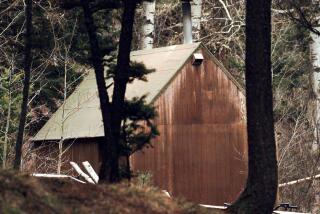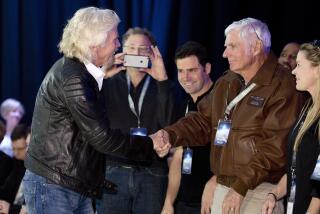The Age of American Inventiveness : How our first operational jet fighter was born : SKUNK WORKS: A Personal Memoir of My Years at Lockheed, <i> By Ben R. Rich and Leo Janos (Little, Brown: $24.95; 350 pp.)</i>
To hear Ben Rich tell it, in his thoroughly engrossing memoir, Libyaâs Moammar Kaddafi is alive today only because Reaganâs Secretary of Defense, Caspar Weinberger, decided, at the last minute, not to use Lockheedâs Stealth F-117A aircraft on the April, 1986, bombing raid against Tripoli.
The Navy fighter-bombers that did make the attack were picked up by Libyan radar, and had to evade missiles and flak, so that their bombs, aimed at Kaddafiâs quarters, missed their target. The F-117A, writes Rich, âwould have attacked with surprise and placed that smart bomb right on the guyâs pillow.â
Weinberger is quoted in the book explaining this bit of curiously benign realpolitik , in which the American government decides to assassinate the head of another government, but chooses not to use its best weapon. He âdidnât want to risk having a plane go down and having its technology explored.â That is, he didnât want the Soviet Union to figure out a defense.
Fat chance. Rich was running the fabled Skunk Works at Lockheed, and his engineers had done their job perfectly: They had produced an aircraft that would show up on radar screens, in the words of the man who created the planeâs design, âas big as an eagleâs eyeball .â An air defense missile canât hit what its radar control canât see.
The proof of the F-117Aâs abilities had to wait five years after the Tripoli raid, when the planes were sent to attack Baghdad as part of Operation Desert Storm. On the first night alone, undetected by ground radar, they knocked out the Iraqi communication and missile centers, air defense center, and the countryâs operational commands. Iraqâs fate was sealed.
This is not only the story of the creation of one aircraft, as fascinating as that tale is. Rich, with the aid of veteran co-author Leo Janos, tells the history of the Skunk Works, created by Lockheed at the end of World War II to come up with Americaâs first operational jet fighter. (It got its name because it was first housed in a tent on the Lockheed operation in Burbank, near a plastics factory which, in those pre-AQMD days, emitted a noxious odor that had the effect of discouraging curious visitors.)
The man who headed the operation was Clarence âKellyâ Johnson, famous in aviation circles for the design for the Electra and Super Constellation commercial airliners, as well as the P-38 Lightning during WWII.
Johnson was crusty, profane, demanding and instinctively brilliant about aviation design. His team gave the country the F-80, and, over the years, the U-2 spy plane, as well as the SR-71, which was taken out of service in 1990, after 24 years overflying the former Soviet Union, China, Vietnam, North Korea and other hostile countries where over a hundred SAM missiles were fired at it--and not one plane was lost.
Rich was not as distinctive (or polarizing) a personality as Johnson, nor was he as intuitively brilliant about aeronautics (although as a young engineer he did win a patent for a wire that would heat the urine elimination tubes on Navy patrol planes, thereby solving a particularly painful sticking problem).
Johnson led by sheer force of personality, and coined a slogan for the Skunk Works: âBe quick, be quiet, be on time.â Rich was a more adept manager, a function of a low-key personality. Unlike some in aerospace, who took government contracts as an invitation to pad expenses, especially in the 1980s, when the U.S. spent around $2 trillion to build weapons, Rich followed Johnsonâs precept to keep the operation lean. Having âachieved phenomenal efficiencyâ building the Stealth fighters, âI offered to give the government some of the money backâ but--no surprise--âThe Air Force told me that it had no bookkeeping methods for taking back money, so I gave them $30 million worth of free engineering improvements on the airplane.â
Rich retired from Lockheed just as his Stealth planes became the technological and military stars of the Gulf War. He predicts that âthe Skunk Works will endure and remain unrivaled for advancing future technology,â defining that future most dramatically in terms of a world abundant with bloody wars, and dictators no less loathsome than those in the Soviet Union merely because they have fewer resources with which to produce their evil mischief.
As almost all of the aerospace news in Southern California over the past few years has been about layoffs and downsizing, Richâs book is a welcome antidote, a reminder of the days when that industry and this region were suffused with optimism.
He also has a prescription for at least some of what ails us: âWe encouraged our people to work imaginatively, to improvise and try unconventional approaches to problem solving, and then got out of their way. By applying the most common-sense methods to develop new technologies, we saved tremendous amounts of time and money, while operating in an atmosphere of trust and cooperation both with our government customers and between our white-collar and blue-collar employees. In the end, Lockheedâs Skunk Works demonstrated the awesome capabilities of American inventiveness when free to operate under near ideal working conditions.â
More to Read
Sign up for our Book Club newsletter
Get the latest news, events and more from the Los Angeles Times Book Club, and help us get L.A. reading and talking.
You may occasionally receive promotional content from the Los Angeles Times.








